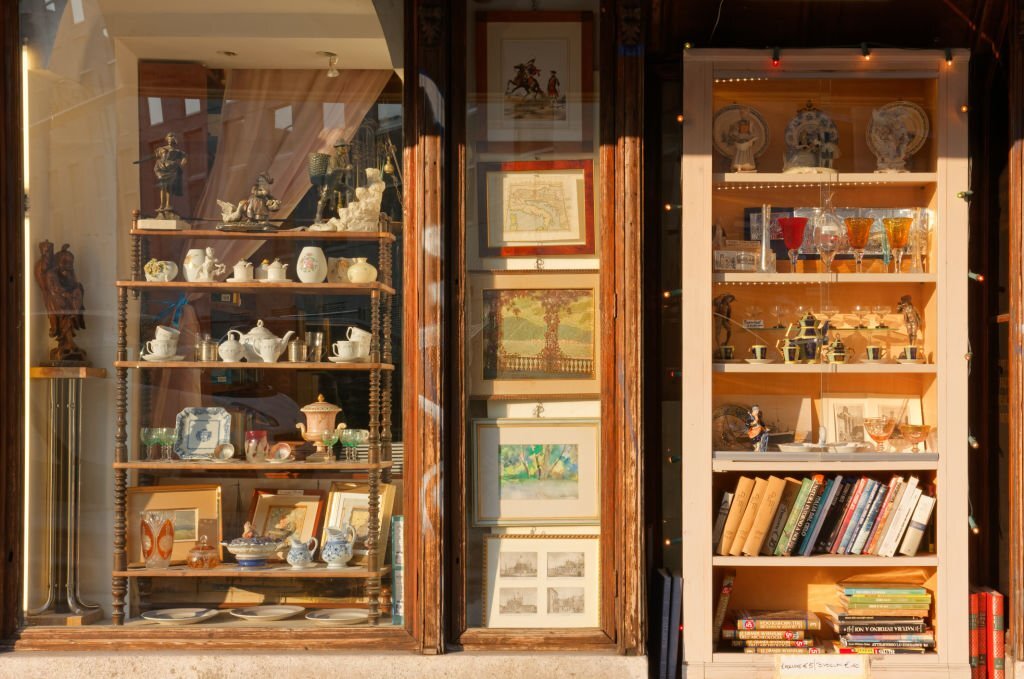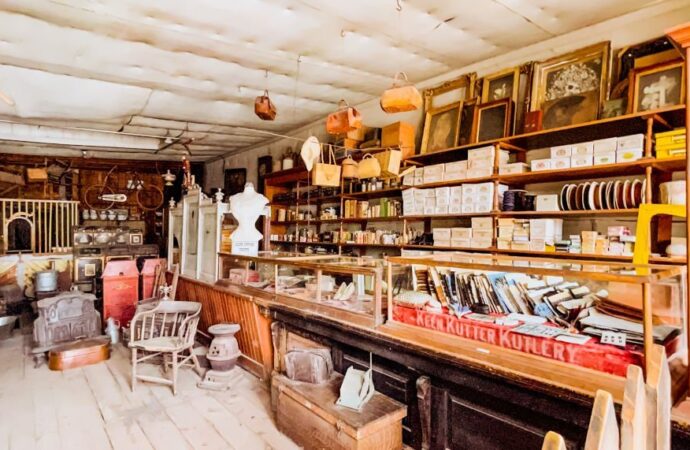The history of Antique Stores may be traced back to the 18th century. At that point, those shops were referred to as “interest shops.” They bought a huge variety of items, together with books, furnishings, and artwork. In the nineteenth century, vintage shops became more specialized, focusing on one type of item, such as furniture
The history of Antique Stores may be traced back to the 18th century. At that point, those shops were referred to as “interest shops.” They bought a huge variety of items, together with books, furnishings, and artwork. In the nineteenth century, vintage shops became more specialized, focusing on one type of item, such as furniture or artwork. Antique Stores are still in operation today, selling a diverse range of items.
The History of Antique Stores: How They Evolved Over Time
Antique stores have been around for hundreds of years and have grown in popularity recently. But how did those stores come about? And how have they advanced over time?
The history of vintage shops is a protracted and charming one. These shops have their origins in the historic international, and they have gone through a number of modifications over the centuries.
The first antique stores were most likely established during the historic period. These shops had probably been created by rich folks who desired to display their collections of art and other objects.
The first recorded instance of an antique shop comes from Rome in the 1st century BC. A rich Roman named Lucius Caecilius Iucundus is believed to have opened the first store of its type.
Over the centuries that followed, the reputation of vintage shops grew. Since the Middle Ages, these shops have become increasingly common in Europe.
One of the most well-known vintage stores in history was set up in Paris in the 17th century. This shop, called the Cabinet des Curiosités, was created by King Louis XIV.
The Cabinet of Curiosities became full of all types of oddities and curiosities. It became a famous vacation spot for the wealthy and curious.
The recognition of antique stores began to fade within the 18th century. This was because of a variety of factors, which include the rise of the middle class and the commercial revolution.
However, antique shops made a comeback in the late 19th and early 20th centuries. This turned into a renewed interest in all things vintage and beautiful.
Today, antique stores are more popular than ever. These shops provide a completely unique opportunity to buy items that might be both lovely and historical.
The Early History of Antique Stores
The first antique Stores appeared in America in 1750. It became referred to as “The Old Curiosity Shop” and turned into a place in Boston. The shop became owned by John Cushing, who was an avid collector of antiques. Cushing’s store became very successful, and soon other vintage shops started to open up in other towns across America.
The popularity of vintage shops continued to develop over the course of the 1800s. Many rich Americans began to accumulate antiques as a hobby. Antique shops became a common sight in most important towns.
The reputation of vintage shops declined in the early twentieth century. This happened because of various factors, together with the Great Depression and the rise of industrially produced items. However, vintage shops made a comeback in the Nineteen Fifties and Sixties as more people realized the value of unique, handcrafted items.
Today, vintage stores are as popular as ever. They are an incredible place to find specific, one-of-a-kind items that will add positive feature appeal to your home.
The Development of Antique Stores
The first antique shop opened in America in 1720 in Boston. Antique stores started to become extremely popular in the early 1800s. By the mid-1800s, there were over 500 vintage stores in the United States.
The reputation of antique stores started to decline in the early 1900s. This turned into a problem because of a number of things, including the upward thrust of mass production and the Great Depression. However, vintage stores started to make a comeback in the 1970s. This became popular as the toddler boomer generation developed an interest in collecting antiques.
Today, there are over 3,000 antique shops in the United States. Antique stores are a famous vacation spots for collectors and those who are surely seeking out unique and exciting objects.
The Modern Antique Store
The antique store is a fixture in almost every city and metropolis. They are a popular vacation spot for those who are looking for a special piece of furniture or decor for their home. But how did these stores emerge?
The first vintage shops were truly started with the assistance of people looking for a quick buck. They could buy up antique fixtures and different items from estate income and then resell them at a higher rate. This quickly turned into a profitable venture, and the antique store was born.
Over time, the vintage shop has evolved. They are now more likely to be started by humans who have a passion for antiques and want to share that passion with others. These shops are typically full of carefully selected portions that the owner has a personal connection to.
The modern antique store is a far cry from the stores of yesteryear. They are now a vacation spot for people who are looking for a completely unique piece for their home. With the care and attention that goes into choosing each piece, the cutting-edge vintage shop is sure to have something for every person.
The Birth of Antique Stores: Early Origins and Development
The history of vintage stores is a protracted and varied one, with the earliest examples dating back countless years. In fact, the first winery is thought to have opened around 300 BCE in Rome. This keeps referred to as the Tabernae Vinariae, offering wine and different alcoholic beverages.
Over time, the idea of the vintage has evolved and changed. In medieval Europe, for instance, there were shops referred to as “jumble sales” that sold a number of secondhand goods. These shops were frequently located in market squares and were well-known among those who couldn’t afford to buy new items.
During the Renaissance, the concept of the antique kept changing. This time, the focus turned to artwork and collectibles. These shops were regularly run by rich families who had collected large collections of artwork and different items.
The modern antique watch is a fantastically new invention. The first ones were regarded as dating from the late 18th century in Britain and America. These shops had been designed to sell a huge variety of secondhand goods, from furniture to clothes.
Today, vintage shops are an important part of the global financial system. They provide a place for humans to shop for and sell a huge range of objects, from the mundane to the uncommon and valuable. Additionally, they play a crucial role in maintaining records and subcultures.

The Victorian Era and the Rise of Antiquarianism
The Victorian Era became a time of superb trade in England. One of the most notable changes was the rise of antiquarianism. The study and collection of antiquities, which are objects that are at least a hundred years old, is known as antiquarianism.
The Victorian Era became a time of top-notch alternate in England. One of the most extraordinary modifications was the rise of antiquarianism. Antiquarianism is the study and collection of antiquities, which can be anything older than 100 years.
The Victorian Era changed into a time of the tremendous exchange in England. One of the most superb modifications was the rise of antiquarianism. Antiquarianism is the study and collection of antiquities, which are gadgets that can be at least 100 years old. There were numerous reasons for the rise of antiquarianism during the Victorian era.
One reason for the rise of antiquarianism was the growth in wealth over the course of the Victorian Era. This allowed people to shop for more highly-priced items, including antiques. Another reason led to the growth in leisure time. People had more time to devote to hobbies like collecting.
The upward push of antiquarianism also coincided with the rise of middle elegance. The middle class became interested in matters that were correct and first-rate. They saw antiquarianism as a way to expose their wealth and flavor.
The Victorian era was a time of first-rate commerce in terms of how people perceived the previous. The Victorians believed that looking back could help them recognize the present.
The upward thrust of antiquarianism caused the establishment of many establishments, consisting of museums and historical societies. These establishments aided in the preservation and dissemination of the Bible to the general public.
The Victorian Era became a time of top-notch change in England. The upward push of antiquarianism became one of the many changes that took place during this time.
The Twentieth Century and the Emergence of the Antique Market
The twentieth century became a time of amazing exchange and upheaval. With the upward thrust of the economic revolution, mass production became the norm, and people started to value goods that had been heavily produced and were easy to achieve. This change in values led to the emergence of the vintage marketplace.
Antique stores are businesses that sell vintage, frequently uncommon objects. These shops have been around for hundreds of years, but they became more common in the twentieth century as the demand for antique goods increased.
Today, vintage shops are a popular destination for individuals who are searching for particular gadgets. They sell a wide range of items, from furniture to jewelry, and they provide a glimpse into the future.
Antiques in the Digital Age: How Technology is Changing the Industry
What comes to mind when you think of an antique keep? For a lot of us, a dusty vintage shop full of knick-knacks and old furniture is appealing. However, the vintage clothing industry has developed significantly over the years, thanks in part to advances in technology.
In the early days of vintage stores, sellers would source their products from property sales, auctions, and personal collections. They could then market their wares through physical stores, exchanges, and flea markets CLICK HERE
The internet has modified the antique store industry in a number of ways. With a few clicks of the mouse, they can search online auction websites, commercials, and dealer directories to locate what they’re seeking.
The net has additionally made it easier for antique shops to reach a much wider target market. Capacity clients would have to physically go to a store in the future to see what had changed into something for sale. Now, many shops have their own websites on which they show off their merchandise. Some even promote items online.
Technology has also changed the way vintage stores do business. For instance, many shops now use automated stock systems to keep track of their products. Furthermore, point-of-sale (POS) structures make it simple for customers to make purchases and for store owners to process transactions.
The changes that generation has brought to the antique store industry have been mostly positive. Thanks to the net, it’s simpler than ever for sellers to find merchandise and for customers to discover the right piece for their home or collection.
The Future of Antique Stores: Challenges and Opportunities
The future of vintage stores is full of possibilities. On the one hand, the net has made it simpler than ever for humans to buy and promote antiques online, which has cut into the traditional brick-and-mortar commercial enterprise of vintage stores. On the other hand, the recognition of shows like Antiques Roadshow and American Pickers has created a new generation of vintage collectors who’re inclined to pay top dollar for unique and particular items.
The key to achievement for vintage shops within their destiny might be to embrace the changes that the net has brought about and to discover new ways to reach their potential customers. One method is to collaborate with online antique sellers or to enter your personal items into an internet archive. Another way to stand out in a crowd is to specialize in a specific type of antique or period, such as mid-century modern furniture or vintage toys.
Whatever course antique stores take in the future, one factor is certain: the love of antiques and the desire to personalize a chunk of history is not going away anytime soon. With a touch of ingenuity and a variety of hard paintings, the destiny of antique stores seems brilliant.
From Curio Shops to High-End Boutiques: A Look at Antique Store Formats
The first vintage shops have been referred to as “curio shops,” and they first appeared in Europe within the sixteenth century. These stores were commonly run by family members who inherited their collections from preceding generations. The term “curio” comes from the Latin phrase for “care” or “worry,” and those stores had been regularly filled with gadgets that were considered to be unusual.
As the recognition of collecting antiques grew, so did the number of curio stores. By the nineteenth century, there were masses of curio stores in London alone. These shops were frequently run by people who were no longer expert dealers, and the quality of the items on offer should vary greatly.
In the 20th century, the vintage commercial enterprise started to professionalize, and the primary antique dealerships appeared. These dealerships were frequently run by people who had a deep understanding of antiques and were able to supply first-rate objects. They also started out specializing in particular kinds of antiques, including furniture, silver, and porcelain.
Today, there are curio stores and antique dealerships. Curio shops are still usually run with the aid of family members who’ve inherited their collections, and the exceptionality of the objects on offer can nonetheless vary significantly. Antique dealerships, however, are run by professional dealers who have deep knowledge of antiques and may provide a wide range of high-quality gadgets.
How Antique Stores Have Adapted to Social and Cultural Changes Over the Years
The antique store is a staple of the American retail landscape. These organizations had been around for hundreds of years, and they showed no signs or symptoms of disappearing any time soon.
While the idea of the antique store has remained enormously unchanged over the years, the way those stores perform has surely advanced to keep up with social and cultural adjustments.
One of the biggest modifications that antique stores have had to adapt to is the rise of online shopping. In the past, if a person wanted to shop for a vintage item, they could physically visit a store and purchase it in character.
Now, with a few clicks of a button, human beings can buy antiques from the comfort of their own homes. This has compelled many antique stores to change the way they do commercial enterprise.
For example, many stores now have a web presence where they promote their items through an internet store or auction site. This permits them to attain a far wider target market than they ever may have wanted to before.
Now, there is a developing demand for more unique and eclectic gadgets. This has led many shops to increase the types of gadgets they sell and to recognize the importance of promoting objects that are more uncommon and exciting.
As you can see, antique stores have had to adapt to some major changes over the years. However, they remain a popular vacation destination for customers looking for something unique and special.
Famous Antique Stores and Their Impact on the Industry
The History of Antique Stores: How They Evolved Over Time
The vintage store is a fixture in nearly every town and city across America. They are a source of nostalgia, an area to discover a completely unique gift, and regularly a source of earnings for individuals who sell their wares inside their walls. But how did these stores come to be? How have they changed over the years?
As the centuries progressed, vintage stores began to pop up in smaller towns and have become extra affordable for the common person. The gadgets on the market also changed, as now many stores promote items that have been made in America.
The twentieth century saw a primary alternative within the antique store industry. The rise of mass production resulted in a decrease in demand for antiques. This, combined with the Great Depression, induced many shops to shut their doors.
In the past couple of decades, there has been a resurgence in the popularity of antique stores. Today, they may be visible as a supply of unique, one-of-a-kind gadgets. They are also a popular vacation spot for people who are looking for a great deal.
The antique shop is part of American history. They have evolved over the years to fulfill the changing needs of society. Whether you’re looking for a special piece of furniture or a hidden gem, an antique store is sure to have something that catches your eye.
The Influence of Design and Decor Trends on Antique Store Offerings
The vintage keep is a fixture in most American cities. These shops provide a wide variety of products, from fixtures to jewelry to artwork. While the services of a vintage clothing retailer can vary widely, there are a few commonalities among these corporations. For starters, most antique stores specialize in selling items that are at least 100 years old. This age requirement guarantees that the items in the store are of a certain quality and sturdiness. This ardor regularly results in a deep knowledge of the objects in the store, which may be helpful to clients who are seeking out specific gadgets.
While commonalities between vintage shops are important, the character offerings of each shop are what distinguishes them. The location of an antique shop is one of the most important factors in determining its offerings. Stores in big cities are likely to carry a wider variety of objects than shops in small towns. This is because massive towns typically have a more numerous population, which ends up leading to a greater demand for a huge variety of gadgets. Another issue that can have an effect on the services of an antique store is the type of purchaser that the shop caters to. For example, some stores might also concentrate on selling objects that are popular with a certain age group, institution, or gender.
While the area and customers of an antique shop can have an impact on the types of gadgets that can be provided on the market, the most vital issue that determines the offerings of an antique store is the taste of the owner. As a result, the proprietor has the option of selling items that are in line with current design and decor trends or items that are more traditional. The owner can also choose to sell objects that are in excessive demand or items that are more specific. No matter what the proprietor’s flavor, the services of an antique store are probably going to reflect that.
The Role of Collectors in Shaping the Antique Store Landscape
For centuries, creditors have played a pivotal role in shaping the vintage lending landscape. Their ardor for obtaining unique and uncommon gadgets has driven the marketplace for those objects, and their impact may be seen in the manner in which vintage shops are organized and operated nowadays.
Collectors have traditionally put pressure on the vintage market. In the early days of the market, wealthy creditors would frequently commission dealers to locate specific items for their collections. This courting between collector and supplier turned out to be important to the development of the market because it gave sellers a reason to supply and promote antiques.
As the marketplace grew, collectors began to specialize in certain areas, which included furnishings, artwork, and porcelain. This specialization helped to form the way that antique shops are prepared these days. Additionally, it drove the development of new and innovative methods to display and promote antiques.
Today, creditors are nevertheless a vital part of the vintage marketplace. Their passion for amassing drives the marketplace and their impact can be seen in the manner in which antique stores are operated and prepared.



















Leave a Comment
Your email address will not be published. Required fields are marked with *